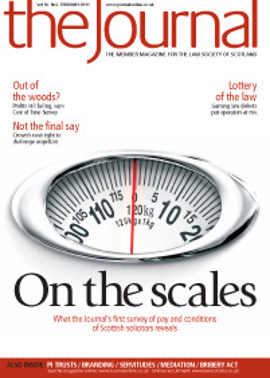The evidence against

Evidence “against” a co-accused
What is now s 266(4)(c) of the Criminal Procedure (Scotland) Act 1995 has its origins in s 1(f)(iii) of the Criminal Evidence Act 1898, a provision which protected (and still protects) a person charged with an offence from cross-examination as to inter alia his criminal record unless he gave evidence “against any other person charged with the same offence”. But what does “evidence against” mean?
The House of Lords formulated an answer in Murdoch v Taylor [1965] AC 574: the words mean “evidence which supports the prosecution’s case in a material respect or which undermines the defence of a co-accused”. But what does “support” mean? Or “undermines”? In Scotland, doubts about the scope of the subsection and the correct test were raised both in McCourtney v HM Advocate 1977 JC 68 and Sandlan v HM Advocate 1983 JC 22, although in both cases Murdoch v Taylor was applied. But the ground has been traversed again, this time by a bench of five judges in Gallagher v HM Advocate [2010] HCJAC 130 (17 December 2010).
The point arose during the trial of two accused on a charge of murder. The first accused lodged a special defence of alibi, but the co-accused intimated an intention to incriminate him. After the first accused had given evidence in chief in support of his alibi, counsel for the second accused was allowed to cross-examine him on his criminal record. The second accused was acquitted, but the first was convicted and argued on appeal that such cross-examination should not have been permitted; his evidence in chief, although inconsistent with the defence of the co-accused, did not “undermine” it. It was argued that while the Murdoch v Taylor formulation had been previously applied in Scotland, no definitive ruling had been given as to its correctness.
The court discussed the history of the statutory provision and how it had been interpreted both in England and Scotland. In Sandlan, Lords Hunter and Dunpark had been particularly troubled by one issue: at the point when a trial judge has to rule as to whether the accused has given “evidence against” his co-accused, how will the judge know what the co-accused’s defence is? However, the third member of the court in Sandlan (Lord Ross) had not shared his colleagues’ concerns; he thought that by the point when a trial judge had to make the decision, in most cases it ought to be perfectly clear from how the defence of the co-accused had emerged up to that point (such as by lodging a special defence or his cross-examination of the Crown witnesses) whether he was undermining the defence of the other accused.
The views of Lord Ross prevailed, the court agreeing that the issue as to whether an accused’s evidence is “against” a co-accused ought to be capable of being decided on an informed basis. It noted also that it will be in the interests of any co-accused who is minded to invoke the subparagraph to make clear what his defence is, so that any objection to its being invoked can properly be repelled.
As to the test in Murdoch v Taylor, the court saw nothing in the Scottish case law which seriously suggested that the test was incorrect, although if it merited reconsideration, that was a matter for Parliament. Applying it to the present case, the first limb was not satisfied, but the second was. The co-accused’s defence was that both he and the appellant were present at the time of the crime, but that only the appellant assaulted the victim. The appellant’s alibi evidence clearly undermined that defence; if it was believed, it put the co-accused’s defence in jeopardy and materially increased the chances of his conviction. The appeal was refused.
Non-disclosure by Crown
In non-disclosure appeals it is clear that it is not sufficient for an appellant to argue that his trial has been unfair simply because the Crown has withheld material which ought to have been disclosed; the significance and consequences of the non-disclosure must be assessed. As Lord Hope put the matter in McInnes v HM Advocate 2010 SCCR 286 at paras 20 and 24, the test to be applied is whether, taking all the circumstances of the trial into account (including the non-disclosure in breach of the appellant’s right), there is a real possibility that the jury would have arrived at a different verdict: that is, the jury might reasonably have come to a different view on the issue to which it directed its verdict if the withheld material had been disclosed to the defence.
In Hay v HM Advocate [2010] HCJAC 125 (9 December 2010), the appellant had been unanimously convicted of attempted murder. By an oversight the Crown had failed to disclose that one of its witnesses had a previous conviction and another had charges pending, leading to the complaint that had this material been available to the defence it could have been used to cross-examine the witnesses, undermine their credibility and reliability and in general support the appellant’s account of events.
The appeal court had little difficulty in refusing the appeal, pointing to the weight of evidence against the appellant from other witnesses. Three of these identified the appellant as the assailant, another gave a description matching his clothing, and there was forensic evidence identifying a spot of the complainer’s blood on the leg of the appellant’s jeans. Looking at the whole circumstances, the McInnes test was not met.
No discount for guilty plea
The decision in Balgowan v HM Advocate [2011] HCJAC 2 (12 January 2011) will make uncomfortable reading for an accused person whose plea of guilty is rejected, who goes to trial and then is convicted of the exact crime to which he earlier tendered a plea. What discount on sentence, if any, is appropriate under s 196 of the Criminal Procedure (Scotland) Act 1995? This point was examined in Spence v HM Advocate 2007 SCCR 592 and was developed in the instant case.
Following the rejection of his plea to culpable homicide on a charge of murder, the accused pleaded not guilty, initially having lodged a special defence of self defence. But he departed from that position at the beginning of the trial and ran a special defence of incrimination until the proceedings ended with his conviction for culpable homicide. No discount was allowed by the trial judge, a decision upheld on appeal. The plea originally tendered was not adhered to (as it might have been); and the fact that a trial had to be conducted in its entirety on the whole evidence meant that no utilitarian benefit resulted from the tabling of the restricted plea.
Cadder and current appeals
As anticipated, the first appeals raising Cadder points have begun before the High Court. One such is Birnie v HM Advocate [2011] HCJAC 4 (20 January 2011), a case where an 18-year-old accused had been interviewed under caution by the police on 14 May 2009 in respect of an allegation of indecent assault and abduction. He declined the assistance of a solicitor during the interview and was charged with the offences. He was then told he would be kept in custody over the weekend, whereupon he elected to make a voluntary statement, again having declined legal assistance.
In the statement he made certain damaging admissions, which formed crucial corroborative evidence against him at his subsequent trial. This began on 7 December 2009, almost a year after the ECtHR Grand Chamber decision in Salduz v Turkey (2009) 49 EHRR 19 but less than two months after the decision of the High Court in HM Advocate v McLean (22 October 2009), where it was held that Scots law adequately protected an accused person in such circumstances. McLean had appeared on the SCS website almost immediately at [2009] HCJAC 97, but had not yet been fully reported at the time of his trial.
The accused was convicted on a reduced charge and appealed, originally on grounds unrelated to Cadder. But when his appeal called on 16 November 2010, the court itself directed him to lodge and intimate to the Crown a proposed additional ground of appeal in order to focus a Cadder point. He did so, also taking the opportunity to propose further grounds based on defective representation at the original trial, on the basis that (a) counsel had failed to take timeous objection to the admissibility of the purportedly incriminating replies, and (b) those replies had been incorporated in a joint minute of admissions.
When the appeal hearing resumed, the Crown objected to the receipt of all the new grounds, submitting that the appellant had waived his right to legal advice and founding on the fact that no objection to the evidence had been taken at the trial. But the court declined to come to any concluded view on these points, holding only that cause had been shown for allowing the existing note of appeal to be amended by the addition of the new proposed grounds.
As for the Anderson points, the court is presently seeking comments from the trial counsel and solicitor and the appeal has been continued. Significantly, the court stated that the issues raised were of importance, not only to the appellant but for the disposal of other current appeals in like circumstances.
In this issue
- Mutuality in action
- Tough choices
- Show us the files
- RoS launch business eZine
- Rewards of the job
- Pressure points
- Measure for measure
- Rage against the machine?
- Second bite at the cherry
- Personal injury trusts: benefits and PITfalls
- Countdown for Legal Aid Online
- Training: SYLA will play its part
- Law reform update
- Branding or bragging?
- The learning curve
- Ask Ash
- Mediating retirement
- CICA - a question of timing
- The evidence against
- Fought all the way
- Family friendly
- Stakes too high
- Much ado about plenty
- Limits of authority
- Scottish Solicitors' Discipline Tribunal
- Website review
- Book reviews
- Straight dealing
- Servitudes, developers and flexible rights






